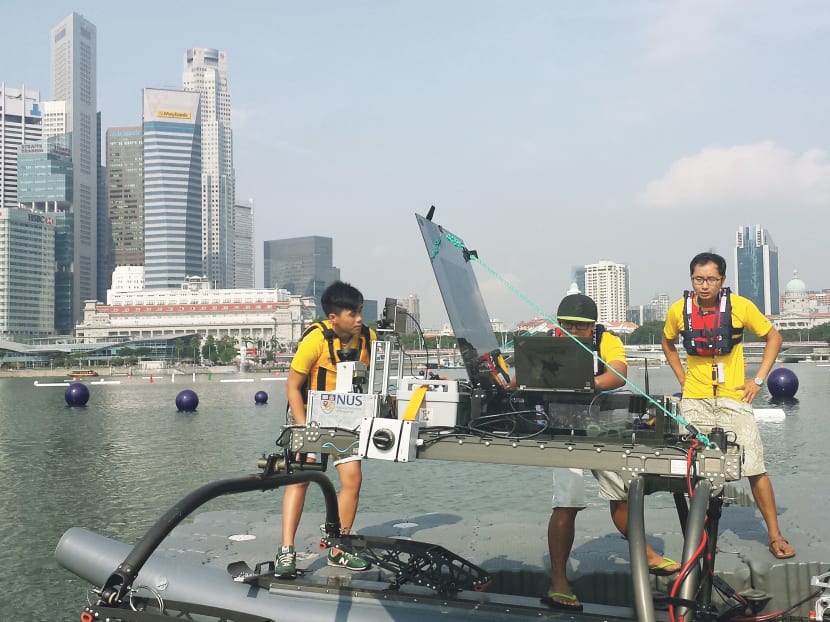Students poised for maritime robot challenge
SINGAPORE — After months of hard work, three teams of Singapore students yesterday launched their maritime unmanned surface vehicles into the waters at the Marina Bay floating platform as they competed in the inaugural Maritime RobotX Challenge.

The NUS team working on their craft during a practice session. Photo: Khairul Amri
SINGAPORE — After months of hard work, three teams of Singapore students yesterday launched their maritime unmanned surface vehicles into the waters at the Marina Bay floating platform as they competed in the inaugural Maritime RobotX Challenge.
They watched with bated breath as their vehicles — retrofitted by the students with sensors, computers and software — completed a set of five tasks autonomously, from navigating along a marked course to observing a light sequence on a buoy and reporting their findings.
They will run through the five tasks again today and tomorrow, after which the top six teams will compete in the finals on Sunday, with the winning team receiving a US$20,000 (S$25,500) cash prize.
The competition, jointly organised by the Association for Unmanned Vehicle Systems International (USA), the National University of Singapore’s (NUS) Faculty of Engineering and Science Centre Singapore, aims to be an experiential learning platform leveraging on science, technology, engineering and mathematics education.
“The Maritime RobotX Challenge hopes to build a culture of international collaboration, and an exchange of science and engineering knowledge among local and international competition participants and experts,” said its co-chair, Professor Chan Eng Soon from NUS.
Unlike many of the teams from universities overseas — a total of 12 overseas teams are competing — this is the first time most of the local students are taking part in such a competition. The local teams, which started their preparations in the second half of last year, are from NUS, Nanyang Technological University (NTU) and Singapore University of Technology and Design (SUTD).
Mr Shen Bingquan, 30, a PhD student mentoring the NUS team, said the team was nervous initially yesterday since it was the first time their craft had completed the whole course autonomously. “(But) I think it went well,” he added. He hoped to improve in the next two rounds.
But their lack of expertise was a concern for some of them.
“Our team is young, we (SUTD) are still new and don’t have a batch that’s graduated yet. Other teams have PhD and Master’s students to guide them, and also proper research labs in their universities for them to work on their project,” said 21-year-old Tushar Mohan from SUTD, as he pointed to competition from the likes of the Massachusetts Institute of Technology and The University of Tokyo. The students had sought advice from their professors instead.
Other challenges the teams faced included manpower constraints and putting together the components needed for their vehicles.
In December last year, more than three months into the planning stage, the NUS team saw half its members leave due to other commitments or a lack of interest.
“We’re lucky our website and Facebook page are up and updated regularly. There were four or five of us left. So, in December, we did a mass publicity drive to attract more members and three or four joined, purely out of interest,” said Mr Tamilarasan Teyagarajan, 24.
NTU team manager Ondrej Bruna, 29, said their biggest challenge was the “integration of the different components of the project and coordination”.
SUTD’s Mr Tushar recounted his team’s experience when they tested the craft on water for the first time. “It started raining harder and harder when we got to Pandan Reservoir to test the vehicle. We weren’t sure how waterproof the components were, but we went ahead anyway. After a distance, the craft stopped moving. We were lucky that the current brought back the craft within pulling distance!”
Each team had a US$25,000 grant from organisers to kick-start their project, but could look for other forms of funding. The competition is planned to be a biennial affair, with the next instalment to be in 2016.
More information about the teams can be found at http://www.robotx.org.








